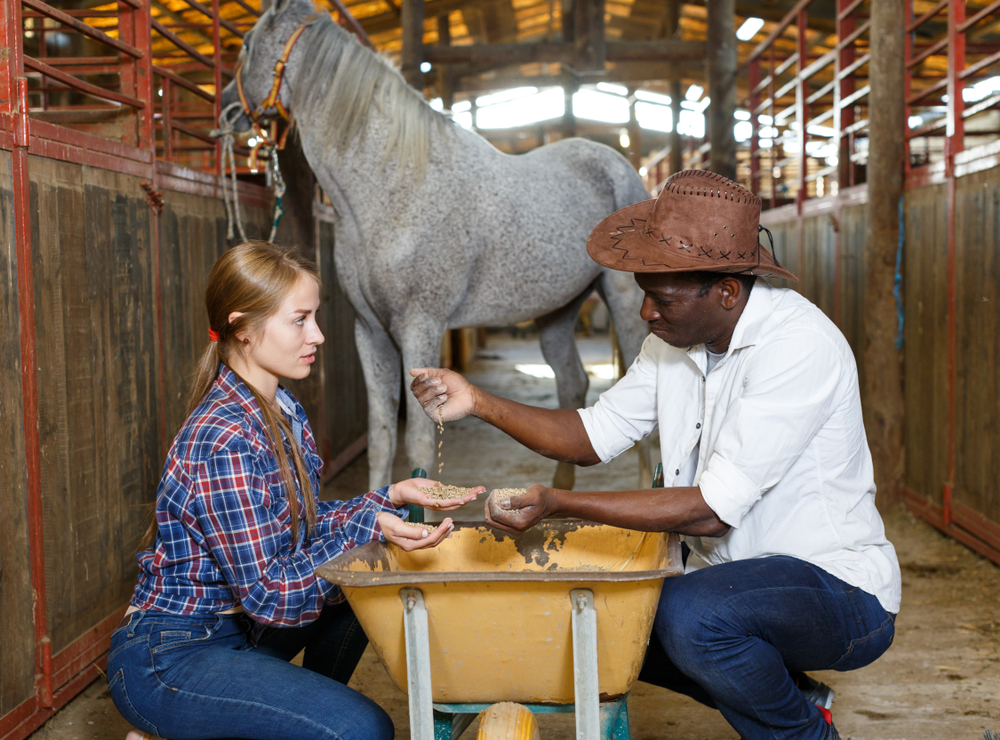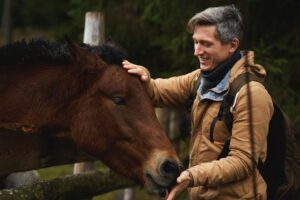Food is essential to a horse’s life. In this blog post, we are going to answer the question hoe much grain to feed a horse per day.
Horse owners need to ensure that their horses are being fed the correct type of food. A well-balanced diet will provide the horse with all the essential vitamins, minerals, and nutrients required for optimal health. Feeding your horses suitable grains is necessary for their health and well-being. Grains provide a vital source of energy, vitamins, and minerals for healthy growth and development in a horse’s diet. The type of grain you choose should be specific to your animal’s needs – it should match their individual nutritional requirements. But if this is something new, you might ask how much grain to feed a horse per day.
So, How Much Grain To Feed A Horse Per Day?
When it comes to feeding your horse, you must know what type of horse you have and how much they need to eat. Some horses require more nutrients than others, while some are easier to feed and require fewer. The amount of grain you should feed your horse will depend on several factors, such as size and activity level. Generally, a good rule of thumb is 1-2 pounds per 100 lbs of body weight per day for adult horses at maintenance. Pregnant or lactating horses’ needs can be higher due to the added physical demands placed on their bodies. For better assurance, consult your veterinarian to determine a dietary plan best suited to your horse’s needs and lifestyle.
It is also important to talk to your vet or nutritionist to get advice on how much and what type of food should be given to your horse. This way, you can ensure that your horse gets all the nutrients it needs for optimal health. Remember that feeding your horse grain should always be accompanied by plenty of forage (hay or pasture).
Too Much Or Grain
When a horse overeats grain, the results can be severe and even fatal. A rapid increase in sugar levels in the bloodstream, known as “grain overload”, can lead to colic, a severe abdominal pain caused by intestinal gas or blockages. Horses are also at risk of laminitis, an inflammation of the laminated structures that support their hooves. Laminitis is incredibly painful for horses and can cause long-term lameness if not caught early on and treated promptly. As grain contains high levels of starch, it can cause acidosis – an imbalance in the pH level of a horse’s stomach, which leads to poor digestion and gut problems.
Overeating grain can also result in weight gain and general lethargy, harming the horse’s health. For all these reasons, it is imperative for horse owners to monitor their horses’ diet and ensure that grain is fed in moderation. Overfeeding grain can have serious consequences and should only be done under the guidance of a veterinarian or equine nutritionist.
Too Little Grain
When a horse doesn’t consume enough grain, it can develop various problems. Energy deficiency is one of the most common, which can lead to weight loss and slower growth. A horse not consuming enough grain may also become lethargic, experience poor hoof quality, and have a weak immune system due to a lack of essential nutrients such as vitamins and minerals.
Additionally, insufficient grain intake can cause digestive issues, including colic or diarrhea. These health issues can be very serious for your horse if left untreated, so it’s crucial to ensure they get the right amount of grains in their diet. Talk with your veterinarian about what type of grain would be best for your horse’s needs.
Read More: Horse Food Recalled After 45 Deaths
How Much Is Enough Grain Per Day?
Feeding your horse grain in multiple smaller meals is a great way to ensure that your horse receives the nutrition it needs. By breaking up the grain into several feedings throughout the day, you can be sure that your horse’s digestive system will be able to absorb and use all of the nutrients from its food. Plus, it allows your horse to mimic its natural grazing habits more closely. If you must give a large grain at once, consider an additional lunchtime feeding so your horse can easily digest and benefit from the meal.
Consider the amount of pasture or hay that your horse is getting daily. If your horse has plenty of access to good quality pasture most of the day, you may not need to provide any additional hay in their diet. However, they cannot graze on grass regularly, or the pasture isn’t of excellent quality. In that case, you should supplement with more hay — whether they remain stabled or are turned out. You must provide adequate fiber in their diet no matter what situation they’re in.
Not Just Grains, But Feed Your Horse Some Forage
It’s essential to make sure your horse is getting enough forage in its diet. For horses grazing on good pasture, they typically only need access to hay if their turnout time is limited. Either that or the quality of the field could be better. However, horses kept inside or that don’t have access to good quality pasture may require more hay in their diets. Feeding the right amount of hay is essential to keeping your horse healthy and happy.
It’s essential to monitor your pasture closely during winter and drought. When the grass isn’t so lush, supplementing grazing with hay will help protect your animals from malnutrition and dehydration. If you do provide fodder, adjust the amount according to available pasture. During times of thick and lush grass, you can reduce or even eliminate hay rations entirely.
In Conclusion
Proper feeding habits need to be established. This is to ensure that your horse receives the correct amount of nutrition daily. Feeding them too little or too much can cause serious health issues and should be avoided. Regular veterinarian check-ups will help you track your horse’s nutritional intake and ensure they stay healthy. Knowing what your horse needs can help ensure it gets the right amount of nutrients and stays healthy. Click the link here to learn more about American Quarter Horse.



